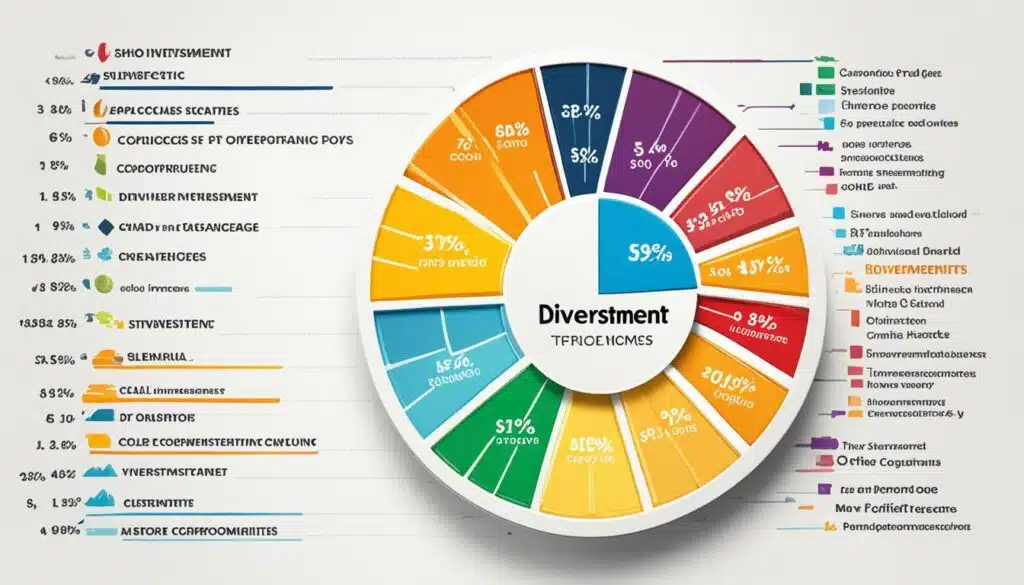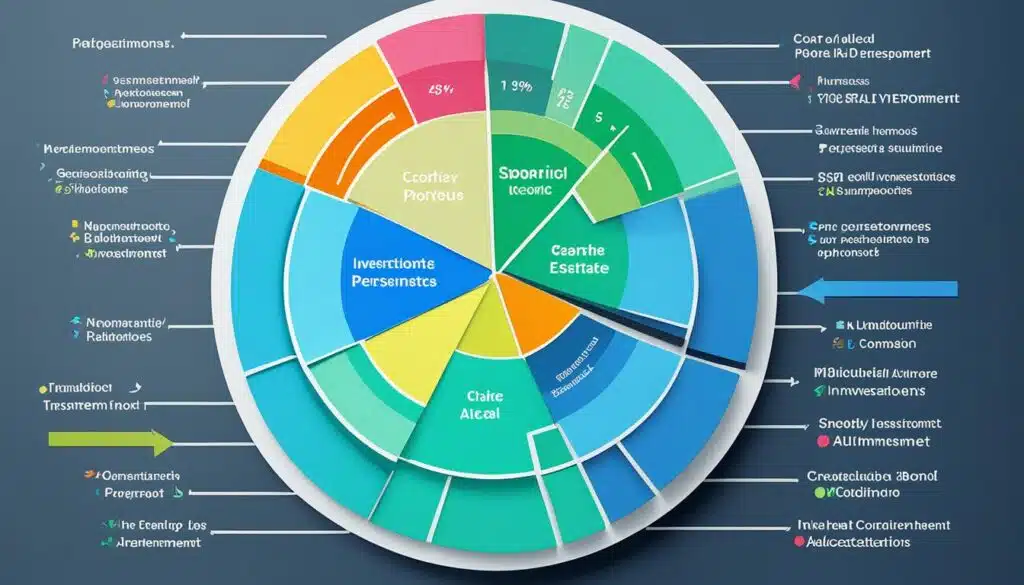Investing for the long term can seem tough, especially with the changing market. Yet, some key principles can help you build wealth over time. By using a strategic plan and staying disciplined, you can handle market ups and downs. This way, you set yourself up for long-term growth.
Key Takeaways
- Embrace a long-term investment horizon to ride out short-term market fluctuations.
- Diversify your portfolio to mitigate risk and enhance returns.
- Focus on value and growth investing strategies to uncover undervalued and high-potential companies.
- Develop a tailored investment plan based on your life stage and financial goals.
- Adopt disciplined investment strategies like buy-and-hold and dollar-cost averaging.
The Importance of Long-term Investing
Securing your financial future is crucial for many. A key way to do this is through long-term investing. This approach is better than quick trades. It offers big benefits.
Understanding the Benefits of a Long-term Approach
Long-term investing helps you beat the ups and downs of the market. It also stops you from making decisions based on feelings. Studies show that holding onto investments for over three years is smart. It means you pay less tax on gains than with short-term investments.
Overcoming Short-term Volatility and Emotions
- Choosing a long-term investment strategy helps you ride out market changes. It stops you from making quick, impulsive choices.
- This method also helps you deal with your emotions. These can lead to bad decisions when markets are shaky.
- In the end, sticking with a long-term strategy gives you the calm and patience needed. It helps you make the most of long-term investing.
Investing for the long haul takes discipline but offers big rewards. Knowing the value of a long-term approach helps you handle market ups and downs. It also keeps emotions from guiding your choices. This way, you set yourself up for financial success over the years.
Also Read :Emergency Fund Savings Tips: Smart Ways To Build Funds
Diversification: A Cornerstone of Long-term Investment Strategies

Long-term investment plans rely on diversification. By spreading your investments across various asset types, sectors, and regions, you reduce risk. This strategy helps you tap into different potential returns, crucial for long-term financial success.
Diversification is more than a trend; it’s a proven method to strengthen investment portfolios. If one market does poorly, a diversified portfolio can lessen the blow. Other parts might do well, balancing out the losses.
It’s not just about risk management. Diversification also lets you benefit from the different performances of assets and sectors. This way, you’re not too tied to one investment’s success or failure. It leads to a more stable and predictable return over time, aiding in reaching your financial goals.
| Asset Class | Potential Benefits | Potential Risks |
|---|---|---|
| Equities | Long-term growth potential, exposure to economic expansion | Increased volatility, susceptibility to market fluctuations |
| Bonds | Stable income, lower volatility, diversification from equities | Interest rate risk, credit risk, inflation risk |
| Real Estate | Potential for capital appreciation, stable rental income | Illiquidity, exposure to local market conditions |
| Commodities | Inflation hedge, portfolio diversification | Volatility, exposure to commodity price fluctuations |
Diversification is key for long-term investment success. It’s not just a tip; it’s a core principle. By spreading your investments, you manage portfolio diversification, asset allocation, and risk management effectively. This approach leads to sustainable growth and financial security.
“Diversification is the only free lunch in investing.” – Harry Markowitz, Nobel Laureate in Economics
Also Read :How Do I Create A Personalized Financial Plan?
Value Investing: A Time-Tested Approach

In the fast-changing world of investing, value investing is a reliable method. It’s been popularised by big names like Warren Buffett. This approach looks for undervalued stocks that are worth more than their current price. By using value investing principles, investors can make the most of the market’s mistakes.
Identifying Undervalued Companies
At the core of value investing is a deep look into a company’s basics. Investors check the company’s financial health, its place in the market, and its growth chances. They look at things like price-to-earnings ratios and dividend yields to find hidden gems.
The Principles of Value Investing
There are key principles that guide value investing:
- Patience and Long-term Thinking: Investors take a long view, ready to hold onto stocks for years. This lets the market see the real value of the company.
- Margin of Safety: They buy stocks well below their true value, which protects against losses.
- Fundamental Analysis: Deep research into a company’s finances and its place in the industry is key to finding real value.
- Emotional Discipline: Investors stay focused on the long-term, ignoring short-term ups and downs and following their own strategy.
By following these principles, value investors can profit from the market’s mistakes. This leads to strong long-term gains.
Growth Investing: Capitalising on Future Potential

Growth investing is a strategy for those looking to make the most of high-growth companies. It’s about picking firms with strong growth potential. The goal is to earn big returns as these companies grow and succeed.
Also Read :These 50 Photos Of Unique People Show That Genetics Is Hard To Forget
Identifying High-Growth Companies
Finding success in growth investing means spotting companies with big growth potential. These companies are often in the tech sector but can be in other areas too. They stand out by putting profits back into the business, not paying out dividends.
- Look for firms with a strong competitive edge, like new products, unique tech, or leading market share.
- Check the company’s past growth, focusing on revenue, earnings, and market share.
- Look at the company’s future growth chances, considering things like industry trends, laws, and the vision of the management.
By picking high-growth stocks with big return potential, growth investors can set their portfolios up for long-term wins.
“The secret to investing is to figure out the value of something – and then pay a lot less for it.”
– Warren Buffett, renowned investor and growth enthusiast
Investment Strategies for Different Life Stages
Creating effective investment strategies needs careful thought. It should match your life stage and financial goals. Whether you’re saving for retirement or education, a customised investment plan can boost your long-term financial security.
Investing for Retirement
For retirement planning, focus on a mix of assets that offer steady income and growth. This could include stocks, bonds, and low-risk investments. By considering your time frame, how much risk you can handle, and what income you need, you can tailor your retirement portfolio.
Investing for Education
For education savings, like college tuition, a cautious approach is best. Using fixed-income securities and money market funds can help. These options reduce the effect of market ups and downs. Tax-advantaged accounts like 529 plans can also grow your savings faster.
Adjusting your investment strategy for different life stages is key to success. Matching your investments with your financial goals and risk level increases your chances of reaching your goals. This could mean a comfy retirement or funding your child’s education.
Also Read: How To Achieve Financial Independence?
Investment Strategies

Long-term investing has two key strategies: buy and hold investing and dollar-cost averaging. These methods help investors grow their wealth over time.
Buy and Hold Strategies
The buy and hold strategy means picking top companies or funds and keeping them for years. It uses compounding to grow investments over time. By not constantly trading, investors dodge short-term market ups and downs.
Dollar-Cost Averaging
Dollar-cost averaging is another smart way to invest for the long haul. It involves putting the same amount of money into the market at set times, no matter the market state. This method helps reduce the effects of market swings, buying more when prices are low and less when they’re high. It’s great for retirement savings or long-term financial goals.
Buy and hold investing and dollar-cost averaging are great for those aiming for long-term growth. They help reduce the impact of short-term market changes. By using these long-term investment strategies, investors can achieve their financial goals with confidence.
Also Read : Learn Proven Real Estate Investment Strategies For Success
Asset Allocation and Portfolio Rebalancing

Creating a strong investment plan is more than picking stocks or funds. It’s key to know about asset allocation and portfolio rebalancing. By spreading your money across different asset classes, like stocks, bonds, and real estate, you make a diversified portfolio. This helps it handle market changes better.
Understanding Asset Classes
Each asset class has its own set of risks and rewards. Stocks might offer big returns but are also more unpredictable. Bonds are usually steadier but give lower returns. Real estate can offer a mix of these, adding stability and growth potential to your portfolio.
Maintaining a Balanced Portfolio
- It’s vital to check and tweak your asset allocation regularly to keep your risk and reward in line with your goals.
- This action, called portfolio rebalancing, keeps you on course with your investment aims and controls risk.
- By keeping your portfolio spread across asset classes, you boost the chance for steady, long-term growth.
Getting the balance right between asset allocation and portfolio rebalancing is key to long-term investing success. Knowing the details of various asset classes and actively managing your diversified portfolio helps you better handle market changes. This way, you can reach your financial goals more effectively.
Risk Management in Long-term Investing

In the world of long-term investing, managing risks is key to keeping your portfolio safe and reaching your financial goals. The stock market can be unpredictable, but experienced investors know how to handle the ups and downs. They focus on their long-term goals.
One top strategy for managing risks is diversification. By investing in different areas, like various industries and regions, investors can reduce the risk of one investment failing. This helps protect their whole portfolio.
Another important part of managing risks is asset allocation. Investors balance their money between stocks, bonds, real estate, and more. This makes sure their risk matches their investment time frame and how much risk they can handle.
| Asset Class | Risk Profile | Allocation Range |
|---|---|---|
| Stocks | Higher Risk | 50-70% |
| Bonds | Lower Risk | 20-40% |
| Real Estate | Moderate Risk | 5-15% |
Regular portfolio rebalancing is key for a well-managed portfolio. By adjusting their investments now and then, investors keep their asset mix right for their long-term goals. This is important as market conditions change.
“The essence of portfolio management is the management of risks, not the management of returns.”
– Benjamin Graham, father of value investing
Using these strategies, long-term investors can handle market volatility. They can focus on growing their wealth over time. This helps protect their investments and reach their financial goals.
Conclusion
In the world of investing, long-term strategies are key. The stock market can be unpredictable, but with the right approach, you can build wealth over time. This article has shown how to make your investments work for you.
By spreading your investments and choosing the right type of investing, you can manage risks better. This increases your chances of reaching your financial goals.
Remember, long-term investing means being patient and disciplined. Avoid quick wins and focus on a steady plan. This way, you can handle market changes and grow stronger over time.
Understanding these strategies lets you take charge of your finances. It’s a step towards a secure and prosperous future. So, start with a balanced investment plan, diversify your assets, and stick to your goals.
This approach will help you navigate the market’s challenges. It’s the key to making the most of your long-term investment strategies, investment portfolio, financial planning, and wealth building in the UK.
FAQs
What are the most effective long-term investment strategies?
Investing in the stock market is full of uncertainty. Yet, some principles can boost your chances for long-term success. Key advice includes focusing on winning investments and cutting losses early. Avoiding penny stocks and sticking to a chosen strategy is also crucial. If you have time, focus on long-term investing for better profits.
What are the benefits of a long-term investment approach?
Investing for the long term is a solid way to secure your financial future. It helps you avoid the pitfalls of short-term trading and emotional decisions. Holding assets for more than three years is considered long-term. This approach also benefits from more favourable tax rates on capital gains after a year.
Why is diversification important for long-term investment strategies?
Diversification is key for long-term investment success. It spreads your investments across different areas, reducing risk and increasing potential returns. This approach helps protect your portfolio from poor performance in any one area. It’s essential for managing risk and achieving long-term financial goals.
What is value investing, and how does it work as a long-term strategy?
Value investing is a strategy that focuses on buying companies at a discount to their true value. Investors look at a company’s financial health and growth potential to find undervalued stocks. They hold these stocks long-term, waiting for the market to recognize their true worth.
What is growth investing, and how can it be a successful long-term strategy?
Growth investing targets companies with high growth potential. These companies often reinvest their earnings to expand, not pay dividends. Growth investors aim to profit from these companies’ growth. Finding companies with strong growth prospects is central to this strategy.
How can investors tailor their investment strategies to different life stages and financial goals?
Investors should adjust their strategies based on life stages and financial goals. For retirement, focus on building a diversified portfolio for income and growth. For education funds, consider more conservative investments. Aligning strategies with life stages and goals is key to long-term success.
What are the key long-term investment strategies of buy and hold and dollar-cost averaging?
Buy and hold and dollar-cost averaging are effective long-term strategies. Buy and hold involves holding solid investments for the long term, benefiting from compounding. Dollar-cost averaging involves investing regularly, regardless of market conditions. Both strategies help long-term investors grow wealth while reducing the impact of short-term market swings.
How do asset allocation and portfolio rebalancing contribute to effective long-term investment strategies?
Asset allocation and rebalancing are vital for long-term success. Understanding different asset classes and their performance is crucial for a diversified portfolio. Regular rebalancing helps investors stay on track with their goals and manage risk. A well-diversified portfolio can lead to consistent, long-term growth.
What are the key risk management strategies for long-term investing?
Risk management is crucial for long-term investing. A measured approach can help investors navigate market volatility. Strategies like diversification and rebalancing are key. They help investors manage risk and stay focused on their long-term financial goals.









